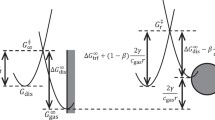Abstract
The operation of gas-generating porous electrodes (GGPE) is studied qualitatively and quantitatively in the entire range of overvoltages. The range comprises a low-overvoltage region, a transition region, and a low-polarizability region. The first region extends to the instance when first gas pores form at the rear surface of GGPE. In the second region, the formation of a gas channel begins. This is the channel through which gas is removed from GGPE by filtration. The formation of the gas channel is completed when first gas pores emerge at the front surface of GGPE. In the third, gas is removed by a powerful process, specifically, by gas filtration in gas pores. The current in the last region increases very rapidly. The presented theory reveals basic parameters that determine the nature and principal features of polarization curves (PC). In all the regions, PC are calculated with constants close to those typical for chlorine generation in DSA. It is shown how the porous space structure (pore types, distribution of pores by size in the presence of micropores and macropores, maximum and minimum pore radii) and parameters that characterize outer-diffusion limitations (processes that occur in the electrolyte chamber) define all characteristics of GGPE and, which is more, define the shape of PC. Using results of this mathematical modeling of gas generation and removal in porous electrodes and electrolyte chamber, one can start looking for ways to purposefully alter the porous space structure of GGPE (in particular, DSA) in order to subsequently optimize characteristics of DSA and GGPE of other types.
Similar content being viewed by others
REFERENCES
Pecherskii, M.M., Gorodetskii, V.V., Evdokimov, S.V., and Losev, V.V., Elektrokhimiya, 1981, vol. 17, p. 1087.
Evdokimov, S.V., Gorodetskii, V.V., and Losev, V.V., Elektrokhimiya, 1985, vol. 21, p. 1427.
Evdokimov, S.V. and Gorodetskii, V.V., Elektrokhimiya, 1986, vol. 22, p. 782.
Evdokimov, S.V. and Gorodetskii, V.V., Elektrokhimiya, 1986, vol. 22, p. 982.
Evdokimov, S.V., Yanovskaya, M.I., Roginskaya, Yu.E., et al., Elektrokhimiya, 1987, vol. 23, p. 1509.
Evdokimov, S.V., Gorodetskii, V.V., Yanovskaya, M.I., and Roginskaya, Yu.E., Elektrokhimiya, 1987, vol. 23, p. 1516.
Evdokimov, S.V. and Gorodetskii, V.V., Elektrokhimiya, 1989, vol. 25, p. 1139.
Gorodetskii, V.V., Evdokimov, S.V., and Kolotyrkin, Ya.M., Itogi Nauki Tekh., Ser. Elektrokhimiya, 1991, vol. 34, p. 84.
Heidrich, G.-Y., Podlovchenko, B.I., and Müller, L., Elektrokhimiya, 1988, vol. 24, p. 1119.
Müller, L. and Heidrich, G.-Y., Elektrokhimiya, 1989, vol. 25, p. 1145.
Muller, L., Heidrich, G.-Y., and Podlovchenko, B., J. Appl. Electrochem., 1990, vol. 20, p. 686.
Podlovchenko, B.I., Maksimov, Yu.M., Heidrich, G.-Y., et al., Elektrokhimiya, 1991, vol. 27, p. 864.
Schonfuss, D. and Muller, L., Electrochim. Acta, 1994, vol. 39, p. 2097.
Schönfu, D., Spitzer, H.-J., and Müller, L., Elektrokhimiya, 1995, vol. 31, p. 1008.
Chirkov, Yu.G., Elektrokhimiya, 2000, vol. 36, p. 526.
Chirkov, Yu.G. and Chernenko, A.A., Elektrokhimiya, 2001 (in press).
Chirkov, Yu.G. and Rostokin, V.I., Elektrokhimiya, 2001 (in press).
Chirkov, Yu.G. and Rostokin, V.I., Elektrokhimiya, 2001, vol. 37, p. 336.
Chirkov, Yu.G. and Pshenichnikov, A.G., Elektrokhimiya, 1984, vol. 20, p. 1542.
Chirkov, Yu.G. and Pshenichnikov, A.G., Itogi Nauki Tekh., Ser. Elektrokhimiya, 1988, vol. 27, p. 199.
Chirkov, Yu.G., Elektrokhimiya, 1971, vol. 7, p. 1512.
Chirkov, Yu.G., Elektrokhimiya, 1971, vol. 7, p. 1681.
Chirkov, Yu.G., Elektrokhimiya, 1972, vol. 8, p. 567.
Chirkov, Yu.G., Elektrokhimiya, 1972, vol. 8, p. 723.
Chirkov, Yu.G., Elektrokhimiya, 1972, vol. 8, p. 1074.
Chirkov, Yu.G., Elektrokhimiya, 1972, vol. 8, p. 1195.
Chirkov, Yu.G. and Pshenichnikov, A.G., Elektrokhimiya, 1994, vol. 30, p. 941.
Roginskaya, Yu.E. and Morozova, O.V., Electrochim. Acta, 1995, vol. 40, p. 817.
Author information
Authors and Affiliations
Rights and permissions
About this article
Cite this article
Chirkov, Y.G., Rostokin, V.I. Gas-Generating Porous Electrodes: Effect of the Porous Space Structure on Polarization Curves. Russian Journal of Electrochemistry 37, 353–362 (2001). https://doi.org/10.1023/A:1016617804777
Issue Date:
DOI: https://doi.org/10.1023/A:1016617804777




